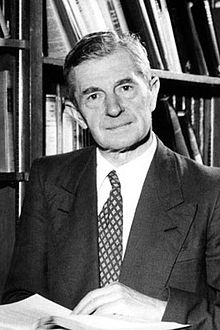Sydney Chapman
Sydney Chapman (born January 29, 1888 in Eccles near Manchester , † June 16, 1970 in Boulder , United States ) was a British physicist, astronomer and geophysicist .
Live and act
Chapman initially wanted to be an engineer and studied at the Royal Technical Institute in Salford . From 1904 he continued his studies on a scholarship at the University of Manchester , where he was tutored by Horace Lamb and John Edensor Littlewood in mathematics. After graduating as an engineer, he studied mathematics and won a 1908 scholarship to Trinity College , Cambridge . He conducted research under Godfrey Harold Hardy in analysis and Larmor on kinetic gas theory. After graduating in 1910, he became a senior assistant to the astronomer Royal Frank Dyson at the Royal Greenwich Observatory . For his work there he was awarded the Smith Prize in 1913. Since he saw himself less as an observing astronomer than as a theoretician, he returned to Cambridge as a lecturer in 1914, where he stayed during the First World War (as a religious pacifist he was exempt from military service).
In 1919 he was appointed Professor of Mathematics at Imperial College London as the successor to Lamb Professor in Manchester and in 1924 as the successor to Alfred North Whitehead .
During the Second World War he worked for the military a. a. about bomb detonators and operations research.
In 1946 he became a Sedleian professor at Oxford and at the same time a fellow at Queen's College there .
In 1953 he retired and was then active as a visiting scientist internationally, mainly in Alaska and in Boulder in Colorado at the High Altitude Observatory, but also in z. B. Cairo , Istanbul , Tokyo , Prague , in the Soviet Union .
He had been married to Katharine Steinthal since 1922, with whom he had a daughter and three sons.
Chapman is known for his contributions to the kinetic theory of gases and to research into terrestrial (from 1913) and interplanetary magnetic fields as well as the ionosphere. He tried to explain changes in the earth's magnetic field through tidal effects of the action of the sun and moon and in 1919 put forward the first theory about the formation of magnetic storms. Chapman also made important work on plasma physics.
Chapman established a first reaction kinetic model for the ozone layer in 1930 and in 1932 derived the distribution of ionization in the ionosphere under the assumption of monochromatic ionizing radiation from the sun. The Chapman layer was named after him (Bakerian Lecture 1927).
From the 1910s he developed, in interaction with the Swede David Enskog, a generalization of the kinetic gas theory of Maxwell and Boltzmann to dense gases. He wrote a book about it in 1939 with Thomas George Cowling ( The mathematical theory of non-uniform gases ).
Independently of Andrei Nikolajewitsch Kolmogorow , he derived the Chapman-Kolmogorow equation .
Awards
Chapman was a Fellow of the London Royal Society since 1919, whose Royal Medal he received in 1934 and whose Copley Medal he received in 1964. In 1928 he received the Adams Prize for work on geomagnetism. From 1929 to 1931 he was President of the London Mathematical Society , whose De Morgan Medal he received in 1944. In 1936 he was elected a member of the Leopoldina , in 1946 of the National Academy of Sciences . He was awarded the gold medal of the Royal Astronomical Society in 1949 . In 1951 he was elected a corresponding member of the Göttingen Academy of Sciences . Since 1953 he was a Fellow of the Royal Society of Edinburgh . In 1956 he received the international Antonio Feltrinelli Prize and in 1969 the Emil Wiechert Medal of the German Geophysical Society . In 1957 he was President of the Special Commission for the International Geophysical Year . The Chapman Medal , awarded by the Royal Astronomical Society since 1973 , is named in his honor. The same applies to Chapman Point , a cape in Antarctica and the Chapman lunar crater .
Web links
- Literature by and about Sydney Chapman in the catalog of the German National Library
- Publications by S. Chapman in the Astrophysics Data System
- John J. O'Connor, Edmund F. Robertson : Sydney Chapman. In: MacTutor History of Mathematics archive .
- Entry to Chapman; Sydney (1888–1970) in the Archives of the Royal Society , London
- Obituaries for S. Chapman in the Astrophysics Data System
Individual evidence
- ↑ Holger Krahnke: The members of the Academy of Sciences in Göttingen 1751-2001 (= Treatises of the Academy of Sciences in Göttingen, Philological-Historical Class. Volume 3, Vol. 246 = Treatises of the Academy of Sciences in Göttingen, Mathematical-Physical Class. Episode 3, vol. 50). Vandenhoeck & Ruprecht, Göttingen 2001, ISBN 3-525-82516-1 , p. 58.
- ↑ Chapman (moon crater) in the Gazetteer of Planetary Nomenclature of the IAU (WGPSN) / USGS
| personal data | |
|---|---|
| SURNAME | Chapman, Sydney |
| BRIEF DESCRIPTION | British astronomer and geophysicist |
| DATE OF BIRTH | January 29, 1888 |
| PLACE OF BIRTH | Eccles near Manchester |
| DATE OF DEATH | June 16, 1970 |
| Place of death | Boulder (Colorado) , USA |
